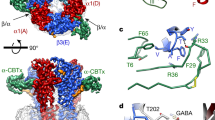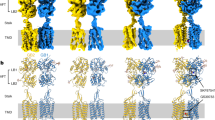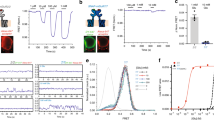Abstract
GABAA (γ-aminobutyric-acid A) and dopamine D1 and D5 receptors represent two structurally and functionally divergent families of neurotransmitter receptors. The former comprises a class of multi-subunit ligand-gated channels mediating fast interneuronal synaptic transmission, whereas the latter belongs to the seven-transmembrane-domain single-polypeptide receptor superfamily that exerts its biological effects, including the modulation of GABAA receptor function, through the activation of second-messenger signalling cascades by G proteins. Here we show that GABAA-ligand-gated channels complex selectively with D5 receptors through the direct binding of the D5 carboxy-terminal domain with the second intracellular loop of the GABAA γ2(short) receptor subunit. This physical association enables mutually inhibitory functional interactions between these receptor systems. The data highlight a previously unknown signal transduction mechanism whereby subtype-selective G-protein-coupled receptors dynamically regulate synaptic strength independently of classically defined second-messenger systems, and provide a heuristic framework in which to view these receptor systems in the maintenance of psychomotor disease states.
This is a preview of subscription content, access via your institution
Access options
Subscribe to this journal
Receive 51 print issues and online access
$199.00 per year
only $3.90 per issue
Buy this article
- Purchase on Springer Link
- Instant access to full article PDF
Prices may be subject to local taxes which are calculated during checkout






Similar content being viewed by others
References
Dohlman, H. G., Thorner, J., Caron, M. G. & Lefkowitz, R. J. Model systems for the study of seven transmembrane segment receptors. Annu. Rev. Biochem. 60, 653–688 (1991).
Unwin, N. Neurotransmitter action: opening of ligand gated ion channels. Cell 72 (suppl.), 653–688 (1991).
Neer, E. J. Heterotrimeric G proteins: organizers of transmembrane signals. Cell 80, 249–257 ( 1995).
McDonald, R. L. & Olsen, R. W. GABAA receptor channels. Annu. Rev. Neurosci. 17, 569–602 (1994).
Mody, I., DeKoninck, Y., Otis, T. S. & Soltesz, I. Bridging the cleft at GABA synapses in the brain. Trends Neurosci. 17, 517–525 ( 1994).
Barnard, E. et al. Subtypes of GABAA receptors: classification on the basis of subunit structure and receptor function. Pharmacol. Rev. 50, 291–313 ( 1998).
Costa, E. From GABA receptor diversity emerges a unified vision of GABAergic inhibition. Annu. Rev. Pharmacol. Toxicol. 38, 321– 350 (1998).
McKernan, R. M. & Whiting, P. J. Which GABA A receptor subtypes really occur in the brain? Trends Neurosci. 19, 139–143 ( 1996).
Tretter, V., Ehya, N., Fuchs, K. & Sieghart, W. Stoichiometry and assembly of a recombinant GABAA receptor subtype. J. Neurosci. 17, 2728–2737 (1997).
Missale, C., Nash, S. R., Robinson, S. W., Jaber, M. & Caron, M. G. Dopamine receptors: from structure to function. Physiol. Rev. 78, 189– 225 (1998).
Sunahara, R. K. et al. Human dopamine D1 receptor encoded by an intronless gene on chromosome 5. Nature 347, 80– 83 (1990).
Sunahara, R. K. et al. Cloning of a gene for a human dopamine D5 receptor with higher affinity for dopamine than D1. Nature 350, 614–619 (1991).
Niznik, H. B., Sugamori, K. S., Clifford, J. J. & Waddington, J. L. in Handbook of Experimental Pharmacology—Dopamine in the CNS. (ed. Di Chiara, G.) (Springer, Berlin, in the press).
Sidhu, A. Coupling of D1 and D5 dopamine receptors to multiple G proteins. Mol. Neurobiol. 16, 125–134 (1998).
Sibley, D. R. New insights into dopaminergic function using anti-sense and genetically altered animals. Annu. Rev. Pharmacol. Toxicol. 39, 313–341 (1999).
Smart, T. G. Regulation of excitatory and inhibitory neurotransmitter-gated ion channels by protein phosphorylation. Curr. Opin. Neurobiol. 7, 358–367 (1997).
Poisbeau, P., Cheney, M. C., Browning, M. D. & Mody, I. Modulation of synaptic GABAA receptor function by PKA and PKC in adult hippocampal neurons. J. Neurosci. 19, 674–683 (1999).
Swope, S. L., Moss, S. I., Raymond, L. A. & Huganir, R. L. Regulation of ligand gated ion channels by protein phosphorylation. Adv. Second Messenger Phosphoprot. Res. 33, 49– 78 (1999).
Yan, Z. & Surmeier, D. J. D5 dopamine receptors enhance Zn2+ sensitive GABAA currents in striatal cholinergic interneurons through a PKA/PP1 cascade. Neuron 19, 1115–1126 (1997).
Radnikow, G. & Misgeld, U. Dopamine D1 receptors facilitate GABAA synaptic currents in the rat subtantia nigra pars reticulata. J. Neurosci. 18, 2009– 2016 (1998).
Moniyama, T. & Sim, J. A. Modulation of inhibitory transmission by dopamine in rat basal forebrain nuclei: activation of presynaptic D1 like dopaminergic receptors. J. Neurosci. 16, 7502–7512 (1996).
Brunig, I., Sommer, M., Hatt, H. & Bormann, J. Dopamine receptor subtypes modulate olfactory bulb γ-aminobutyric acid type A receptors. Proc. Natl Acad. Sci. USA 96, 2456– 2460 (1999).
Bergson, C. et al. Regional cellular and subcellular variations in the distribution of D1 and D5 dopamine receptors in primate brain. J. Neurosci. 15, 7821–7836 ( 1995).
Buhl, E. H., Halasy, K. & Somogyi, P. Diverse sources of hippocampal unitary inhibitory postsynaptic potentials and the number of postsynaptic release sites. Nature 368, 823–828 ( 1994).
Nusser, Z., Roberts, J. D. B., Baude, A., Richards, J. G. & Somogyi, P. Immunocytochemical localization of α1 and β2/3 subunits of the GABAA receptor in relation to specific GABAergic synapses in the dendate gyrus. Eur. J. Neurosci. 7, 630–636 ( 1995).
Hall, R. A., Premont, R. T. & Lefkowitz, R. J. Heptahelical receptor signalling: beyond the G-protein paradigm. J. Cell Biol. 145, 927– 932 (1999).
Sperk, G., Schwarzer, C., Tsunashima, K., Fuchs, K. & Sieghart, W. GABAA receptor subunits in the rat hippocampus: I. Immunocytochemical distribution of 13 subunits. Neuroscience 80, 987–1000 (1997).
Essrich, C., Lorez, M., Berson, J. A., Fritschy, J.-M. & Luscher, B. Postsynaptic clustering of major GABAA receptor subtypes requires the γ2 subunit and gephyrin. Nature Neurosci. 1, 563–571 ( 1998).
Wang, H., Bedford, F. K., Brandon, N. J., Moss, S. J. & Olsen, R. W. GABAA-receptor-associated protein links GABAA receptors and the cytoskeleton. Nature 397, 69–72 ( 1999).
Gorrie, G. H. et al. Assembly of GABAA receptors composed of α1 and β2 subunits in both cultured neurons and fibroblasts. J. Neurosci. 17, 6587–6596 (1997).
Wan, Q. et al. Modulation of GABAA receptor function by tyrosine phosphorylation of β subunits. J. Neurosci. 17, 5062–5069 (1997).
Luttrell, L. M., Ostrowski, J., Cotecchia, S., Kendall, H. & Lefkowitz, R. J. Antagonism of catecholamine receptor signaling by expression of cytoplasmic domains of the receptors. Science 259, 1453–1557 (1993).
Sugamori, K. S., Scheideler, M. A., Vernier, P. & Niznik, H. B. Dopamine D1B receptor chimeras reveal modulation of partial agonist activity by carboxyl terminal tail sequences. J. Neurochem. 71, 2593–2599 (1998).
McDonald, B. J. et al. Adjacent phosphorylation sites on GABAA receptor β-subunits determine regulation by cAMP-dependent protein kinase. Nature Neurosci. 1, 23–28 (1998 ).
Hebert, T. E. & Bouvier, M. Structural and functional aspects of GPCR oligomerization. Biochem. Cell Biol. 76, 1–11 (1998).
Marshall, F. H., Jones, K. A., Kaupmann, K. & Bettler, B. GABAA receptors—the first 7TM heterodimers. Trends Pharmacol. Sci. 10, 369–399 (1999).
Jordan, B. A. & Devi, L. A. G-protein coupled receptor heterodimerization modulates receptor function. Nature 399, 697–700 (1999).
Benes, F. M. The role of stress and dopamine-GABA interactions in the vulnerability for schizophrenia. J. Psychiat. Res. 31, 257 –275 (1997).
Huntsman, M. M., Tran, B.-V., Potkin, S. G., Bunney, W. E. Jr & Jones, E. G. Altered ratios of alternatively spliced long and short γ2 subunit mRNAs of the GABA A receptor in prefrontal cortex of schizophrenics. Proc. Natl Acad. Sci. USA 95, 15066–15071 (1998).
Keverne, E. B. GABA-ergic neurons and the neurobiology of schizophrenia and other psychosis. Brain Res. Bull. 48, 467– 473 (1999).
Okubo, Y. et al. Decreased prefrontal dopamine D1 receptors in schizophrenia revealed by PET. Nature 385, 634– 636 (1997).
Goldman-Rakic, P. S. & Selemon, L. D. Functional and anatomical aspects of prefrontal pathology in schizophrenia. Schizo. Bull. 23, 437–458 (1997).
Moore, H. West, A. R. & Grace, A. A. The regulation of forebrain dopamine transmission. Biol. Psychiat. 46, 40– 55 (1999).
Ng, G. Y. K. et al. Agonist induced desensitization of dopamine D1 receptor stimulated adenylyl cyclase activity is temporally and biochemically separated from D1 receptor internalization. Proc. Natl Acad. Sci. USA 92, 10157–10161 (1995).
Nusser, Z., Hajos, N., Somogyi, P. & Mody, I. Increased number of synaptic GABAA receptors underlies potentiation at hippocampal inhibitory synapse. Nature 395, 172– 177 (1998).
Wan, Q. et al. Recruitment of functional GABAA receptors to postsynaptic domains by insulin. Nature 388, 686– 690 (1997).
Kneussel, M. et al. Loss of postsynaptic GABAA receptor clustering in gephyrin deficient mice. J. Neurosci. 19, 9289–9297 (1999).
Hall, R. A. et al. The β2 adrenergic receptor interactions with the Na+/H+-exchanger regulatory factor to control Na+/H+ exchange. Nature 392, 626–630 (1998).
Yu, X.-M. & Salter, M. W. Gain control of NMDA receptor currents by intracellular sodium. Nature 396, 469–474 (1998).
Acknowledgements
We thank J. Braunton, K. M. Zhu and H. Y. Man for technical assistance. This work was supported by grants from NIDA, the Ontario Mental Health Foundation (H.B.N.) and the MRC of Canada (H.B.N., X.M.Y., Y.T.W.). F.L. was supported by a C. Cleghorn Fellowship in Schizophrenia Research and is a fellow of the Canadian Psychiatric Research Foundation; Z.B.P. is a NARSAD Young Investigator. X.M.Y. is an MRC Scholar and Y.T.W. is a Research Scholar of the Heart and Stroke Foundation of Canada. H.B.N. was supported in part by the C.B. Ireland Endowed Fund for Psychiatric Research.
Author information
Authors and Affiliations
Corresponding author
Rights and permissions
About this article
Cite this article
Liu, F., Wan, Q., Pristupa, Z. et al. Direct protein–protein coupling enables cross-talk between dopamine D5 and γ-aminobutyric acid A receptors. Nature 403, 274–280 (2000). https://doi.org/10.1038/35002014
Received:
Accepted:
Issue Date:
DOI: https://doi.org/10.1038/35002014
This article is cited by
-
Converging synaptic and network dysfunctions in distinct autoimmune encephalitis
EMBO Reports (2024)
-
A synaptomic analysis reveals dopamine hub synapses in the mouse striatum
Nature Communications (2022)
-
Electrophysiology of ionotropic GABA receptors
Cellular and Molecular Life Sciences (2021)
-
The voltage-gated potassium channel Shaker promotes sleep via thermosensitive GABA transmission
Communications Biology (2020)
-
Adenosine heteroreceptor complexes in the basal ganglia are implicated in Parkinson’s disease and its treatment
Journal of Neural Transmission (2019)
Comments
By submitting a comment you agree to abide by our Terms and Community Guidelines. If you find something abusive or that does not comply with our terms or guidelines please flag it as inappropriate.



